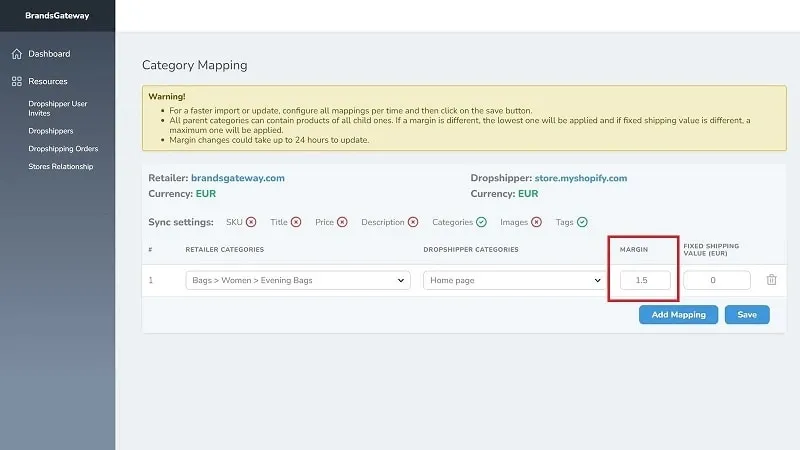
eCommerce
Finding the Perfect Niche for Your Clothing Business?
Embarking on a clothing business adventure is thrilling, yet selecting the ideal niche is the real key to unlocking its...
How Important is Setting your Own Dropshipping Profit Margins
Dropshipping

Managing a dropshipping store involves several essential duties, including taking care of order processing, dealing with delivery services, taking charge of product advertisement, understanding the difference between SKU vs UPC, and creating such product identifiers, to name a few. It’s important that all of these tasks are carried out successfully so that your dropshipping business can prosper and generate great profits. However, regardless if you're following the traditional or the reverse dropshipping model, to be able to reach the desired dropshipping income, you must pay attention to something of equally great importance - setting your profit margins.
In simple terms, the profit margins define your business’s financial gains. If they’re high, you’d benefit from bigger revenue. If they’re low, clearly, you’d get smaller earnings. In order to establish profit margins that would be to your dropshipping store’s advantage, you’d have to take into account the wholesale price of the product as charged by the supplier, the retail price you’ve set, and any type of expenses you might endure, such as shipping costs, as well as consult price comparison websites. However, if you’re a newbie to dropshipping, we won’t blame you if you get lost in all of this information. Calculating profit margins can seem complicated and confusing at first.
That’s why we’ve put together this article to provide you with all the key details you need to know when determining your profit margins. In the following parts of the article, we’ll give you a thorough definition of what a profit margin represents and how you can easily calculate it. However, we’ll focus on elaborating on the importance of designing your own profit margins and how that can have an effect on your store.
Dropshipping profit margin is defined as the amount of money you’ll make for every item you sell in your dropshipping store. It’s calculated in percentage and it shows the exact income you’d receive for every purchase made by your customers. Therefore, it’s fundamental to your business to set up good profit margins for each of your products and constantly monitor them in order to ensure your store’s headed in the right direction. After all, your business’s survival depends on its financial state. The more profitable your store is, the greater success it’ll enjoy.
You can calculate the dropshipping profit margin of a certain product by using the sum you’ve paid for the product and the retail price you’re selling the product for to your customers. The formula looks like this:
Profit margin = (Retail price – Wholesale price) / Retail price x 100
Usually, when dropshipping, the profit margin is set up in the very beginning when importing your supplier’s catalog of products. So, to give an example, let’s suppose you’re running a luxury clothing dropshipping store with BrandsGateway as your supplier. Your customer puts in an order for a pair of Jimmy Choo shoes which is automatically placed with BrandsGateway. After the order has been made, you’ll be able to see the profit you’d be earning. The shoes’ wholesale price amounts to €300, while the recommended retail price is €750. Putting the formula into use, €300 is deducted from the retail price which leaves you with €450 of profit. After dividing that number by the retail price and multiplying by 100, you’ll get your profit margin percentage which amounts to 60%. You can also put into practice the following profit margin formulas for calculating different types of margins.
Profit margins define a set of things that affect your store’s monetary stability. From the revenue, you’d be earning, to the expenses you’ll incur, and any potential financial struggles that might occur. The lack of ability and effectiveness in setting up a lucrative pricing strategy and controlling product costs can lead to unfavorable outcomes for any dropshipper. For that reason, determining your dropshipping profit margins based on your business’s goals and aspirations is a critical point you need to take care of. In the sections that follow we’ve outlined the main reasons behind the importance of taking your time in managing your profit margins.
Profit margins can range from 5% to 100% and even up to 250% in some niches such as designer clothing. However, it’s important to keep in mind that profit margins actually differ from one dropshipping business to another depending on the products that are being sold. In other words, different types of niches have different profit margins. If a certain profit margin generates significant revenues for a dropshipper who sells toys, it doesn’t mean that that same margin will do wonders for a dropshipper that runs an online sports equipment store.
To illustrate, let’s take a look at the profit margins of two dropshipping stores: one sells hygiene products, while the other specializes in luxury apparel. The former is known to have low-profit margins since the items they’re offering are genuinely inexpensive and don’t have a big value. However, these wouldn’t work for the latter store. High-end clothes have a reputation of being very high-priced because they’re extremely valuable, and thus, rank among some of the most profitable items out there. That being said, dropshippers of branded clothing items have the liberty to establish high-profit margins of up to 250% owing to the fact that their products relish international status and recognition.
Taking all of that into consideration, the profit margins depend solely on the merchandise you’re offering. As we saw, some dropshipping ideas such as selling luxury goods bring more earnings than others. Therefore, it’s crucial to take the time and define your own margins based on your anticipated costs, your income expectations, but also your niche’s worth and popularity.
As we’ve just explained, depending on the type of items they sell, industries tend to have completely different profit margins. However, the margin-defining process doesn’t stop there. Products within the same niche have various profit margins as well. This is because not all items will make the same amount of profit. Some will bring significant financial gains, while others will barely make any sales.
As a result, it’s not a good move to go with the same profit margin for all your products. Choosing a different margin for each of them individually it’ll allow you to separate top-selling from poor-selling items. This enables you to track product activity and, thus, efficiently set the profit margins according to their profitability. Therefore, in order to benefit from increased sales, determining product-specific margins it’s of vital importance. For example, even items that fall under the same category, like shoes and sunglasses which are considered accessories, can have different margins, therefore, don’t limit yourself when setting up your margins.

Expenses are an inevitable part of every kind of business. In the dropshipping sector, they come down to shipping fees, advertising expenses, costs charged by the supplier, but also taxes, salaries, page maintenance, etc. Some can be reduced and some don’t, but that doesn’t mean that they’ll cause you unresolvable issues. You’ll be constantly facing unexpected costs as they can’t be predicted, which is why it’s critical to learn how to manage them.
In the process of dealing with a variety of expenses, profit margins will help you immensely in maintaining them round the clock. Having all your product margins set up, you’ll be able not only to easily determine your income but also to see exactly how much money every sale costs you. By calculating profit margins, you’ll be shown the number of expenses your dropshipping store has incurred while selling your products and help you see if you’re putting into action a cost-effective strategy.
Dropshipping businesses are faced all the time with some kinds of inconveniences that might disrupt their work and cause the need to take immediate action. Sometimes it’s better to act upfront and cut the problem at the root before letting it become unmanageable. This is where once again profit margins come into play. Besides landing you a hand in controlling your outgoing costs, profit margins can also assist you in pinpointing issues that might be more problematic than usual on time, in particular financial ones.
For instance, let’s assume that while setting the profit margins for your dropshipping store you notice that your expenses have been rising faster than your revenue. This would signal to you that you need to get to the bottom of the issue that makes your costs higher and try reducing them. Profit margins help you evaluate your business growth and stability. In addition, they provide you with an overview of the matters that contribute to your store’s success and those that might affect it negatively and cause your business plan to go off the tracks.
If you’re hunting for dropshipping suppliers that’ll provide you with striking products of the utmost quality, and most importantly, with high-profit margin items that’ll bring you outstanding incomes, then BrandsGateway might be your ideal solution. Regarded to be among some of the most distinguished online marketplaces in the eCommerce industry, BrandsGateway sells high-end clothing and accessories for men and women designed by numerous fashion reputable brands including Gucci, Dolce & Gabbana, Versace, Jimmy Choo, Carolina Herrera, to name a few.
This esteemed supplier offers dropshipping services to retailers across the globe accessible from its B2B platform, providing them with lucrative product margins of up to 250% of the wholesale price per product sold. For every item in its catalog, BrandsGateway gives suggested retail prices in order to ensure that its customers benefit from high profits. However, it’s important to mention that BrandsGateway doesn’t limit its customers to these prices, but rather they’re offered as guidance, especially for the newbies in the dropshipping business. They present you with realistic selling prices for the products you’ve purchased. Many begin their dropshipping journey with the recommended prices until they’ve gathered enough information on how to come up with good prices by themselves. Nevertheless, depending on their profit goals, BrandsGateway always welcomes dropshippers to build their pricing strategy and set high-profit margins on their own.
In fact, their plugin for dropshipping automation provides the opportunity to set up profit margins per category at the very beginning of the catalog import and adjust them anytime you want, which means you’d be able to experiment, track, and analyze the result of all of the profit margins you’ve set. In the end, you’d be able to conclude which margins are suitable for each type of product you dropship.

Working as a dropshipper entails taking care of a variety of tasks crucial to your business, one of which is ensuring your store is in a good financial position and your sales are reaching your target revenue. Profit margins represent a major factor that defines your store’s profitability and helps you maintain your income. Consequently, in order to make certain that you’ll continue meeting your profit goals, it’s necessary to put an effort into defining your own profit margins.
Determining your product margins and understanding the difference between margin and markup is quite significant for your dropshipping business because of a couple of reasons. Firstly, taking into account the product market they belong to, stores have different profit margins as not every type of product generates the same revenue. Secondly, even within a niche, items require individual margins since some of them won’t sell as much as others. Thus, in order to benefit from high-profit ones, it’s best to focus on your most-purchased merchandise. Finally, your profit margins will assist you greatly in managing your expenses and detecting potential problems that might have a harmful impact on your business. By taking all of these into consideration, you’ll witness improvements not only in your sales but also in your store’s overall performance.
Table of Content
{{TABLE_OF_CONTENTS}}
What is dropshipping?